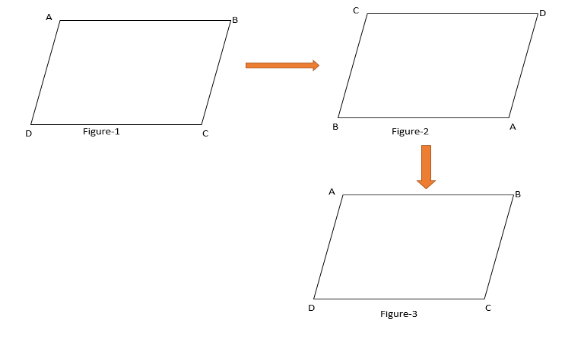
The order of the rotational symmetry of the parallelogram about the centre is
A.0
B.1
C.2
D.3
Answer
555.3k+ views
Hint: We know the definition of rotational symmetry. The order of rotational symmetry of a shape is the number of times you can rotate a shape so that it looks the same. We include the original position but only once, i.e., not when it returns to its original position. We draw the diagram of parallelogram and rotate it about the centre and we find the order of symmetry.
Complete step-by-step answer:
We know that in parallelograms opposite sides are congruent (equal).
See the diagram.

Figure-1 is our original parallelogram. Let’s rotate the figure-1 about the centre through \[{180^0}\]clockwise direction. We obtain the figure-2 which has the same shape as our original parallelogram figure one. Now, let’s rotate the figure-2 about the centre through \[{180^0}\] clockwise direction. We obtain the figure-3 which is the same as figure-1 that is our original parallelogram.
We include the original position but only once, hence the order of the rotational symmetry of the parallelogram about the centre is $2$.
So, the correct answer is “Option C”.
Note: If we rotate the above diagram about the centre through \[{90^0}\], we don’t obtain the same shape as the original. This goes the same for \[{270^0}\]. In the order of rotational symmetry we only care about the shape and the vertices (vertices may differ, see in above diagram). Remember the important note that we include the original position but only once, i.e., not when it returns to its original position.
Complete step-by-step answer:
We know that in parallelograms opposite sides are congruent (equal).
See the diagram.

Figure-1 is our original parallelogram. Let’s rotate the figure-1 about the centre through \[{180^0}\]clockwise direction. We obtain the figure-2 which has the same shape as our original parallelogram figure one. Now, let’s rotate the figure-2 about the centre through \[{180^0}\] clockwise direction. We obtain the figure-3 which is the same as figure-1 that is our original parallelogram.
We include the original position but only once, hence the order of the rotational symmetry of the parallelogram about the centre is $2$.
So, the correct answer is “Option C”.
Note: If we rotate the above diagram about the centre through \[{90^0}\], we don’t obtain the same shape as the original. This goes the same for \[{270^0}\]. In the order of rotational symmetry we only care about the shape and the vertices (vertices may differ, see in above diagram). Remember the important note that we include the original position but only once, i.e., not when it returns to its original position.
Recently Updated Pages
Master Class 9 Social Science: Engaging Questions & Answers for Success

Master Class 9 Science: Engaging Questions & Answers for Success

Master Class 9 English: Engaging Questions & Answers for Success

Master Class 9 Maths: Engaging Questions & Answers for Success

Master Class 9 General Knowledge: Engaging Questions & Answers for Success

Class 9 Question and Answer - Your Ultimate Solutions Guide

Trending doubts
Which places in India experience sunrise first and class 9 social science CBSE

Fill the blanks with the suitable prepositions 1 The class 9 english CBSE

Write the 6 fundamental rights of India and explain in detail

Difference Between Plant Cell and Animal Cell

What is pollution? How many types of pollution? Define it

What is the Full Form of ISI and RAW




